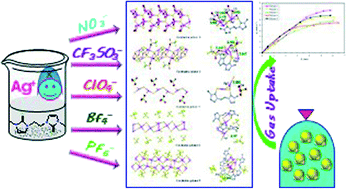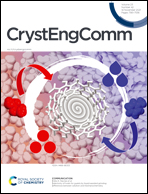Involvement of various anions in tuning the structure of silver(i) coordination polymers based on a S-donor ligand: syntheses, crystal structure and uptake properties†
Abstract
An investigation of the impact of the shape, size and coordination ability of counterions was carried out on five silver(I) 1,2-bis(1-methylthioimidazolyl)ethane coordination polymers, namely, [Ag2L(NO3)2]n (1), [Ag2L(SO3CF3)2]n (2), {[AgL][ClO4]}n (3), {[AgL]2[BF4]2}n (4) and {[AgL]3[PF6]3}n (5). They have been characterized by elemental analysis, IR spectroscopy, PXRD and single-crystal X-ray diffraction. [Ag2L(NO3)2]n (1) was produced in the presence of a strongly coordinating anion (NO3−). In the 1D structure of 1, the ligand appears in a pentadentate form and the nitrate acts as a co-ligand in a bidentate coordination fashion. As in 1, in 2 CF3SO3− with a moderately coordinating potential builds up a natural structure with only one kind of coordination mode for the ligand and two types of coordination geometry for the silver atoms. The difference between structures 1 and 2 can be attributed to the size and coordination ability of their anions, which changed the coordination environment of silver ions without changing the coordination fashion of the ligand. In polymer 3, by decreasing the coordination ability and increasing the size of perchlorate relative to that of the previously considered anions, the coordination mode of the ligand and hence the coordination environment of the silver centers were changed. Unlike all the title compounds in the cationic structure of 3, one of the crystallographically independent AgI centers adopts a distorted trigonal planar environment. Complex 4 with an extended helical chain of [Ag2L]n2+ was obtained when AgBF4 with a small, non-coordinated anion was used to react with the L ligand. X-ray diffraction analysis reveals that the most changes were detected in polymer 5 with a rare triple chain structure and a scarce coordination mode of the ligand by using the bulky, uncoordinated PF6− anion. In fact, changing the type of the anion causes a change in the coordination mode of the ligand and in turn in the structural coordination geometry of the polymer. Additionally, the adsorption potential of the polymers was examined by using NH3 and H2S gases.

- This article is part of the themed collection: Crystal Growth


 Please wait while we load your content...
Please wait while we load your content...